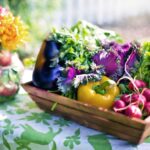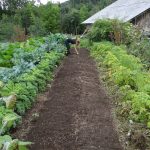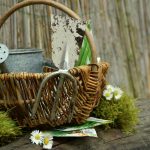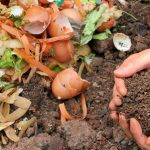Affiliate disclosure: As an Amazon Associate, we may earn commissions from qualifying purchases
Why put in the effort to start growing your own food when you can simply go to the supermarket to get what you need? For every person you ask this question, you might get different answers. However, the majority of the time, people will probably respond with something along the lines of “it helps keep me mobile,” “it saves me money on my weekly shop,” or “I find that it’s a really relaxing hobby.” Whatever your motivation may be, making an effort to grow your own food will almost certainly be rewarding, and anything else is a bonus.
Recently, people are starting to grow their own food due to the recent cost of living crisis. The cost of our weekly food shop has almost doubled, and more and more people are becoming aware of the fact that growing their own fruit and vegetables can be a relatively inexpensive option. So how do you start?

Contents
How do you start growing your own food?
The very first question you have to ask yourself is, “How are you going to start growing your own food?” Figuring out how much space you have to start growing is a great place to begin. Even the smallest of gardens can be used to grow fruit and vegetables, so there is no reason to let the fact that you have limited growing space discourage you from doing so. If you have a small garden, you will want to make the most of the space you have by growing things vertically rather than horizontally. You can also take advantage of a small space by using hanging baskets and stackable plant pots.

Raised beds
Raised beds seem to be the gardener’s first choice for growing fruits and vegetables. I chose raised beds as it helps to eliminate excessive bending. Planting directly in the ground rather than using raised beds is a low-cost option.
There are many different kinds of wood that can be used to construct raised beds. Some people like to make their raised beds out of pallet collars. They are the perfect size for raised beds and they can be stacked one on top of the other. You used to be able to get pallet collars for free. However, companies have now realised that they can make a profit on them. You will probably pay between £5 and £15 each, but even at that price, it is still a bargain when you consider the cost of timber recently.
For my raised beds, I decided to use gravel boards because they seemed to be the most cost-effective option for the size that I wanted. Since this is the first time I’ve done anything like this, I’m not sure how long these will hold up, but I have treated them, so hopefully, they will last a good few years. One of the other things I did to prolong the life of my raised beds was to add a liner so that the soil wouldn’t be sitting directly on the timber.
Planting doesn’t need to be done in raised beds. Many fruits and vegetables can be grown successfully in planters, buckets, containers, and even grow bags. When using smaller pots, it’s important to use good quality multipurpose compost because they tend to dry out more quickly. A 60/40 mixture of compost and soil should be used for larger pots and planters.

Compost
If you start growing your own food, you will generate a lot of garden waste. Making your own compost at home is an effective, sustainable, and natural way to feed your plants as well as get rid of kitchen and garden waste. Over time, the waste you put into the compost bin will decompose naturally into a dark, crumbly material that can be added to your garden as food for new plants. Fruits and vegetables have high nutritional requirements, so it is crucial to add nutrients back into the soil. One way you can do this is by adding compost.
Composting can be done in a compost bin or just placed in a heap. A compost bin is a more efficient way to home compost. The bin holds onto heat, which speeds up the whole process. You can buy one relatively cheaply. You never know; you might even be able to get one on the marketplace for free.

Location
Sunlight is beneficial to plants, but some fruits and vegetables require much more sunlight than others, so it’s important to choose the right location to start your garden. Make sure you check which plants require direct sunlight and which prefer a more shadier spot.

Water source
When choosing the location of your veggie garden, keep in mind that you will need to be close to a water source. Avoid carrying water over long distances if you can, especially if you need to transfer water afterwards, as this can become tiresome.
I personally believe that plants prefer rainwater to tap water, so if you haven’t already, it would be a good idea to invest in a water butt to collect rainwater. Please make sure it is legal where you live because some states, like those in America, do not permit you to collect rainwater. You don’t need to be concerned about collecting rainwater if you live in the UK.
Did you know that when boiled, some of the nutrients from vegetables are released into the water? You can use this nutrient-rich water to water your fruit and vegetables. When washing your vegetables, don’t discard the dirty water as you can also use it to water your garden.

What should I grow?
First things first, make a list of all the fruits and vegetables that are your favourites. You could even try growing a few different varieties of the same fruits and vegetables; you never know, you might favour one variety over another. You should also give some consideration to growing potatoes as well as fresh herbs.
Initially, when you begin gardening, it might be beneficial to start with something simple, like a salad. Compared to other vegetable varieties, salad is a relatively easy vegetable to grow. Start with crops that don’t typically attract many pests or diseases, such as salad leaves, spring onions, and beetroot. Salad crops are very likely to succeed the first time, and they’ll give you the skills and confidence you need to move on to growing more complex fruits and vegetables.

Bring in the pollinators
You might believe that having bees in your garden is something you want to avoid. However, bees are pollinators, and pollination is an essential part of growing fruit and vegetables. Fruits and vegetables require pollination to produce fruit, so you will want to plant flowers to attract pollinators. In addition to bees, butterflies also play a role in the pollination process, so you will want to choose flowers that are appealing to both bees and butterflies. To learn more about bees and how important they are, check out this article about bee facts.








